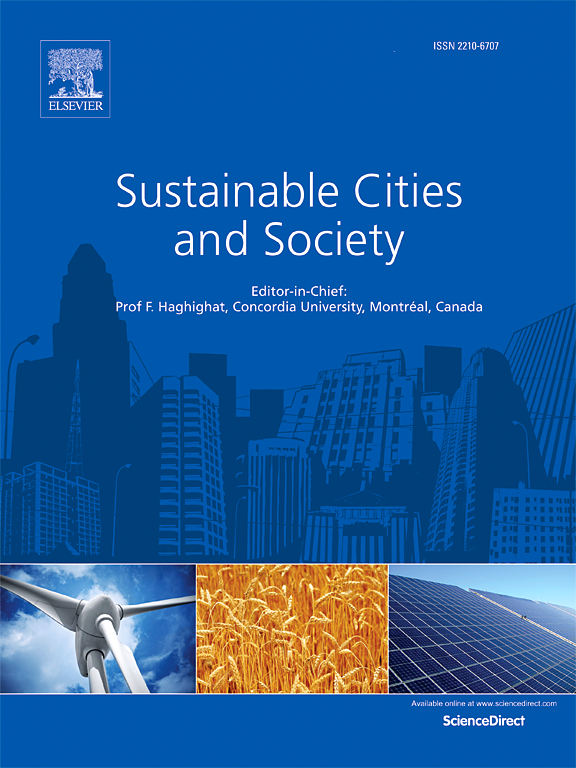Exploring inequality in green space accessibility for women - Evidence from Mashhad, Iran
IF 10.5
1区 工程技术
Q1 CONSTRUCTION & BUILDING TECHNOLOGY
引用次数: 0
Abstract
Green spaces are essential elements of urban structure that contribute to human well-being and health. In some urban societies, women are less mobile and have lower capabilities to benefit from public urban green spaces, therefore more attention should be paid to providing them with equitable access to urban green spaces (UGSs). In this study, we have investigated the availability of and accessibility to UGSs for the total women population and for different groups of women, including homemakers (housewives), and family members they are caregivers for, that is the senior women population and children aged 5 to 14. Spatial criteria analyzed are proximity to urban green spaces, number of UGSs’ service areas overlapping at the block level, per capita urban green spaces, number and distance to public transportation stations, and distance to bike paths in relation and percent of apartments in city blocks presence in Mashhad city. To address the spatial inequities in UGS accessibility, advanced Multi-Criteria Decision-Making (MCDM) methods were utilized. The Best-Worst Method (BWM) was used to weigh the criteria, and the WASPAS, MARCOS, EDAS and COCOSO methods were used to rank the city blocks. These methods enabled a nuanced analysis of disparities in UGS access and provided a robust framework for prioritizing interventions. The results showed that UGSs are not equally accessible for women in the city. Socially and economically privileged classes in Western areas had better access to UGSs, while the need for improved access to UGSs is greater in Eastern regions with lower socio-economic status, which face the greatest accessibility challenges. Meanwhile, clusters of very low access and very high demand for access can be observed in various parts of the city. By integrating these advanced MCDM methods, the study provides a comprehensive approach for evaluating spatial inequities at the residential block level and offers a basis for formulating targeted green city policies. The results allowed for an assessment of the current state and an indication of priority areas for improvement. This methodology, evaluates various conditions at the residential block level, which can be applied both in Mashhad and internationally to support urban planners and policymakers in making informed decisions. Ultimately, it contributes to the equitable distribution of UGSs, enhancing accessibility and usability across diverse groups of women and fostering healthier and more vibrant communities in the women-friendly city.
探索女性在绿色空间可达性方面的不平等——来自伊朗马什哈德的证据
绿色空间是城市结构的基本要素,有助于人类的福祉和健康。在一些城市社会中,妇女的流动性较差,从城市公共绿地中获益的能力较低,因此应更多地关注为她们提供公平的城市绿地(UGSs)。在这项研究中,我们调查了所有妇女人口以及不同妇女群体(包括家庭主妇和她们所照顾的家庭成员,即老年妇女人口和5至14岁的儿童)获得UGSs的情况和可及性。分析的空间标准包括与城市绿地的接近程度、在街区层面重叠的UGSs服务区域的数量、人均城市绿地、到公共交通站点的数量和距离、到自行车道的距离以及马什哈德城市街区中公寓的百分比。为了解决UGS可达性的空间不公平问题,采用了先进的多准则决策方法。采用Best-Worst Method (BWM)对各指标进行加权,采用WASPAS、MARCOS、EDAS和COCOSO方法对城市街区进行排名。这些方法能够对UGS获取方面的差异进行细致的分析,并为确定干预措施的优先次序提供了强有力的框架。结果显示,在城市中,女性并不能平等地获得ugs。西部地区社会经济地位优越的阶层获得UGSs的条件较好,而东部地区社会经济地位较低,面临最大的可及性挑战,需要改善UGSs的获取。同时,在城市的各个地方可以观察到非常低的通道和非常高的通道需求的集群。通过整合这些先进的MCDM方法,该研究提供了一种综合的方法来评估住宅街区层面的空间不平等,并为制定有针对性的绿色城市政策提供了基础。结果允许对当前状态进行评估,并指出需要改进的优先领域。该方法评估了住宅区层面的各种条件,可在马什哈德和国际上应用,以支持城市规划者和决策者做出明智的决策。最终,它有助于公平分配ugs,提高不同妇女群体的可及性和可用性,并在妇女友好型城市中培育更健康、更有活力的社区。
本文章由计算机程序翻译,如有差异,请以英文原文为准。
求助全文
约1分钟内获得全文
求助全文
来源期刊

Sustainable Cities and Society
Social Sciences-Geography, Planning and Development
CiteScore
22.00
自引率
13.70%
发文量
810
审稿时长
27 days
期刊介绍:
Sustainable Cities and Society (SCS) is an international journal that focuses on fundamental and applied research to promote environmentally sustainable and socially resilient cities. The journal welcomes cross-cutting, multi-disciplinary research in various areas, including:
1. Smart cities and resilient environments;
2. Alternative/clean energy sources, energy distribution, distributed energy generation, and energy demand reduction/management;
3. Monitoring and improving air quality in built environment and cities (e.g., healthy built environment and air quality management);
4. Energy efficient, low/zero carbon, and green buildings/communities;
5. Climate change mitigation and adaptation in urban environments;
6. Green infrastructure and BMPs;
7. Environmental Footprint accounting and management;
8. Urban agriculture and forestry;
9. ICT, smart grid and intelligent infrastructure;
10. Urban design/planning, regulations, legislation, certification, economics, and policy;
11. Social aspects, impacts and resiliency of cities;
12. Behavior monitoring, analysis and change within urban communities;
13. Health monitoring and improvement;
14. Nexus issues related to sustainable cities and societies;
15. Smart city governance;
16. Decision Support Systems for trade-off and uncertainty analysis for improved management of cities and society;
17. Big data, machine learning, and artificial intelligence applications and case studies;
18. Critical infrastructure protection, including security, privacy, forensics, and reliability issues of cyber-physical systems.
19. Water footprint reduction and urban water distribution, harvesting, treatment, reuse and management;
20. Waste reduction and recycling;
21. Wastewater collection, treatment and recycling;
22. Smart, clean and healthy transportation systems and infrastructure;
 求助内容:
求助内容: 应助结果提醒方式:
应助结果提醒方式:


